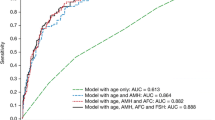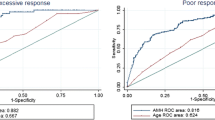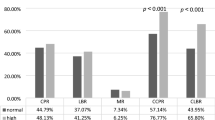Abstract
Objective: Our purpose was to assess the potential role of the baseline hormone profile in combination with the initial pattern of response to gonadotropin releasing hormone (GnRH) analogue in predicting ovarian function and hence reproductive outcome in normogonadotropic patients aged 40 years or older undergoing IVF treatment.
Patients and Methods: A retrospective analysis of 394 controlled ovarian hyperstimulation (COH) cycles that reached the stage of oocyte retrieval was conducted. The study included 163 normogonadotropic (serum FSH ≤15 IU/L) patients aged between 40 and 48 years who had regular menstrual cycles. Superovulation was achieved using menotropins in combination with GnRH analog (short protocol, beginning on menstrual day 2). The ovarian response was monitored on the third cycle day, the day following the first GnRH analogue administration.
Results: Cycle distribution by patient age was 175 (44.4%), 122 (30.9%), and 97 (24.7%), while the patient distribution was 85 (52.2%), 48 (29.5%), and 30 (18.3%) for age groups 40–41, 42–43, and 44–48 years, respectively. The mean total dose of menotropins needed for optimal COH was 1787 IU (range, 600–6000 IU). This dose increased with age, while the yield of oocytes and embryos declined (P<0.05; ANOVA). A positive correlation was demonstrated between the E2 level on day 3 (GnRH analogue flare effect) and the outcome of the treatment cycle (number of oocytes and embryos). Using multiple stepwise regression analysis, it was demonstrated that the initial (day 3) serum E2 levels, combined with baseline FSH levels, patient's age and body mass index enabled early prediction of the ovarian response in the current IVF-ET treatment cycle (oocytes=8.2−0.18×Age+0.17×BMI−0.12×FSH+0.0042×E2).
Conclusions: Multiple-parameter analysis demonstrated that the use of the initial E2 response to GnRH analogue stimulation combined with basic clinical data may assist in the prediction of ovarian function and hence the reproductive outcome in normogonadotropic IVF patients aged 40 years or older. This may serve as a clinical tool for improving patient selection and treatment outcome in IVF-ET.
Similar content being viewed by others
References
Segal S, Casper R: The response to ovarian hyperstimulation and IVF in women older than 35 years. Hum Reprod 1990;3:255–257
Romeu A, Muasher SJ, Acosta AA, Veeck LL, Diaz J, Jones GS, Jones HW Jr, Rosenwaks Z: Results of in vitro fertilization attempts in women 40 years of age and older: The Norfolk experience. Fertil Steril 1987;47:130–136
Padilla SL, Bayati J, Garcia JE: Prognostic value of the early serum estradiol response to leuprolide acetate in in vitro fertilization. Fertil Steril 1990;53:288–294
Scott RT, Toner JP, Mausher SJ, Oehninger S, Robinson S, Rosenwaks Z: Follicle-stimulating hormone levels on cycle day 3 are predictive of in vitro fertilization outcome. Fertil Steril 1989;51:651–654
Toner JP, Philput CB, Jones GS, Muasher SJ: Basal follicle-stimulating hormone level is a better predictor of in vitro fertilization performance than age. Fertil Steril 1991;55:784–791
Muasher SJ, Oehninger S, Simonetti S, Matta J, Ellis LM, Liu HC, Jones GS, Rosewaks Z: The value of basal and/or stimulated gonadotropin levels in prediction of stimulation response and in vitro fertilization outcome. Fertil Steril 1988;50:298–307
Hughes EG, Robertson DM, Handelsman DJ, Hayward S, Healy DL, de Kretser DM: Inhibin and oestradiol responses to ovarian hyperstimulation: Effects of age as predictive value from in vitro fertilization outcomes. J Clin Endocrinol Metab 1990;70:358–364
Buckler HM, Evans A, Mamtora H, Burger GH, Anderson DC: Gonadotropin, steroid and inhibin levels in women with incipient ovarian failure during anovulatory and ovulatory “rebound” cycles. J Clin Endocrinol Metab 1991;72:116–124
Padilla SL, Garcia JE: Effect of maternal age and number of in vitro fertilization procedures on pregnancy outcome. Fertil Steril 1989;52:270–273
Winslow KL, Toner JP, Brzyski RG, Oehniger SC, Acosta AA, Muasher SJ: The gonadotropin-releasing hormone agonist stimulation test—A sensitive predictor of performance in the flare-up in vitro fertilization cycle. Fertil Steril 1991;56:711–717
Fisch B, Kaplan-Kraicer R, Amit S, Ovadia J, Tadir Y: The effect of preinsemination interval upon fertilization of human oocytes in vitro. Hum Reprod 1989;4:954–956
Spencer G: Projections of the population of the United States, by age, sex, and race: 1983–2080.In Current Population Reports: Population Estimates and Projections. Washington, DC, US Department of Commerce, May 1984, Series P-25, No. 952
Westoff CF: Fertility in the United States. Science 1986;234:554–559
Meldrum DR: Female reproductive aging: Ovarian and uterine factors. Fertil Steril 1993;59:1–5
FIVNAT, Piette C, de Mouzon J, Bachelot A, Spira A: In vitro fertilization: Influence of women's age on pregnancy rates. Hum Reprod 1990;5:56–59
Fleming CF, Hughes AO, Williams JA, Ford WCL, Hull MGR: Implantation after IVF according to the woman's age. The 10th Annual Meeting of the ESHRE, Brussels, Belgium, June 1994. Hum Reprod 1994;Suppl 4:117
Verhoeff A, Roest J, van Lent M, Huisman GJ, Zeilmaker GH: Results of IVF treatment in patients above 40 years of age need not be bad. The 10th Annual Meeting of the ESHRE, Brussels, Belgium, June 1994. Hum Reprod 1994;Suppl 4:115
van Kooij RJ, Kastrop PMM, Kortman M, Zonneveld PV, te Velde ER: Age related decrease in implantation rate of IVF embryos. The 10th Annual Meeting of the ESHRE, Brussels, Belgium, June 1994. Hum Reprod 1994;Suppl 4:118
Sauer MV, Paulson RJ, Lobo RA: Pregnancy after age 50: Application of oocyte donation to women after natural menopause. Lancet 1993;341:344–345
Navot D, Bergh PA, Williams MA, Garrisi GJ, Guzman I, Saudler B, Grunfeld L: Poor oocyte quality rather than implantation failure as a cause of age-related decline in female fertility. Lancet 1991;337:1375–1377
Navot D, Drews MR, Bergh PA, Guzman I, Karstaedt A, Scott RT, Garrisi GJ, Hofmann GE: Age related decline in female fertility is not due to diminished capacity of the uterus to sustain embryo implantation. Fertil Steril 1994;61:97–101
Abdalla HI, Burton G, Kirkland A, Johnson MR, Leonard T, Brooks AA, Studd WW: Age, pregnancy and miscarriage: Uterine versus ovarian factors. Hum Reprod 1993;8:1512–1517
McClachlan RI, Healy DL, Robertson DM, de Kretser DM, Burger HG: Plasma inhibin levels during gonadotropin induced ovarian hyperstimulation for IVF: A new index of follicular function? Lancet 1986;1:1233–1234
Navot D, Rosenwaks Z, Margalioth EJ: Prognostic assessment of female fecundity. Lancet 1987;2:645–647
Loumaye E, Billion J-M, Mine J-M, Psalit I, Pensis M, Thomas K: Prediction of individual response to controlled ovarian hyperstimulation by means of a clomiphene citrate challenge test. Fertil Steril 1990;53:295–301
Jacobs SL, Metzger DA, Dodson WC, Haney AF: Effect of age on response to human menopausal gonadotropin stimulation. J Clin Endocrinol Metab 1990;71:1525–1530
Garcia JE, Padilla SL, Bayati J, Baramki TA: Follicular phase gonadotropin-releasing hormone agonist and human gonadotropins: A better alternative for ovulation induction in in vitro fertilization. Fertil Steril 1990;53:302–305
Author information
Authors and Affiliations
Rights and permissions
About this article
Cite this article
Avrech, O.M., Royburt, M., Sabah, G. et al. The initial flare-up induced by gonadotropin releasing hormone agonist May serve as a predictor of ovarian response in the current IVF-ET treatment cycle in normogonadotropic women aged 40–48 years. J Assist Reprod Genet 13, 395–400 (1996). https://doi.org/10.1007/BF02066171
Received:
Accepted:
Issue Date:
DOI: https://doi.org/10.1007/BF02066171




